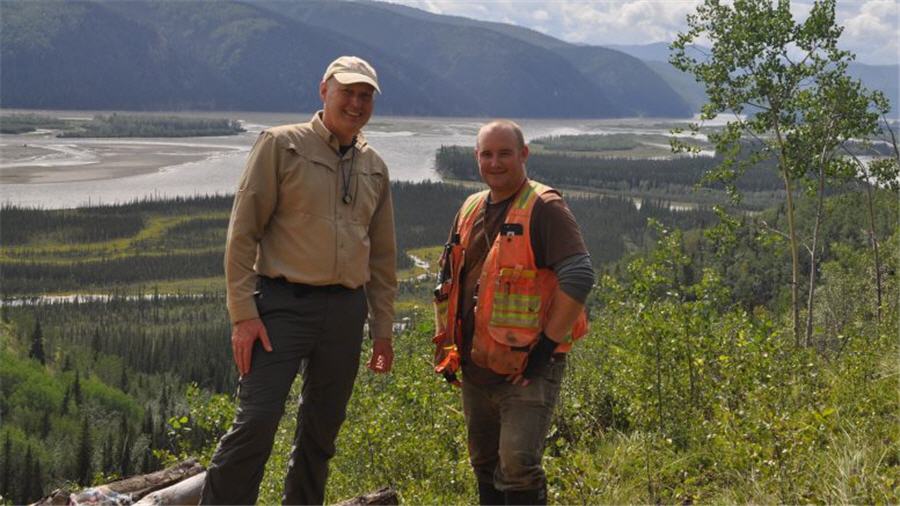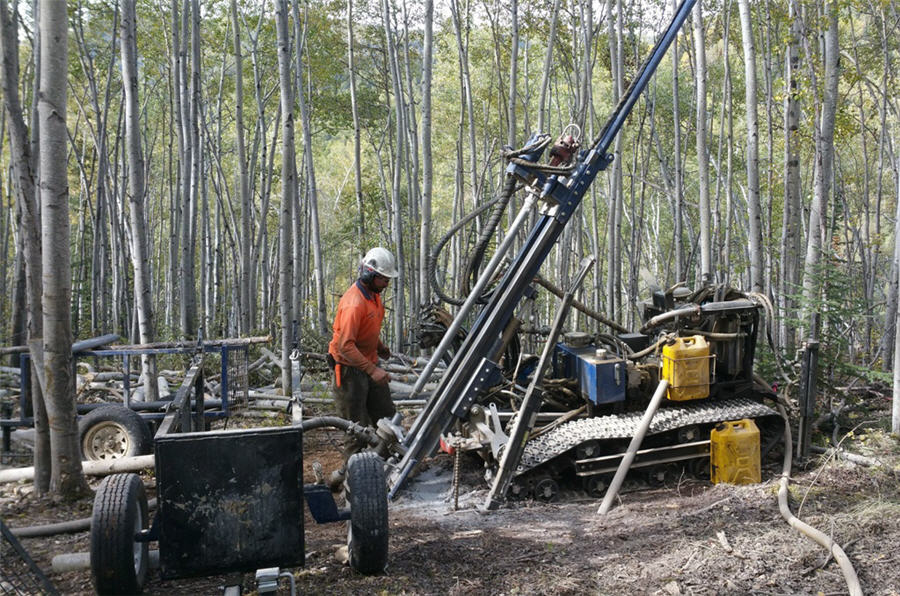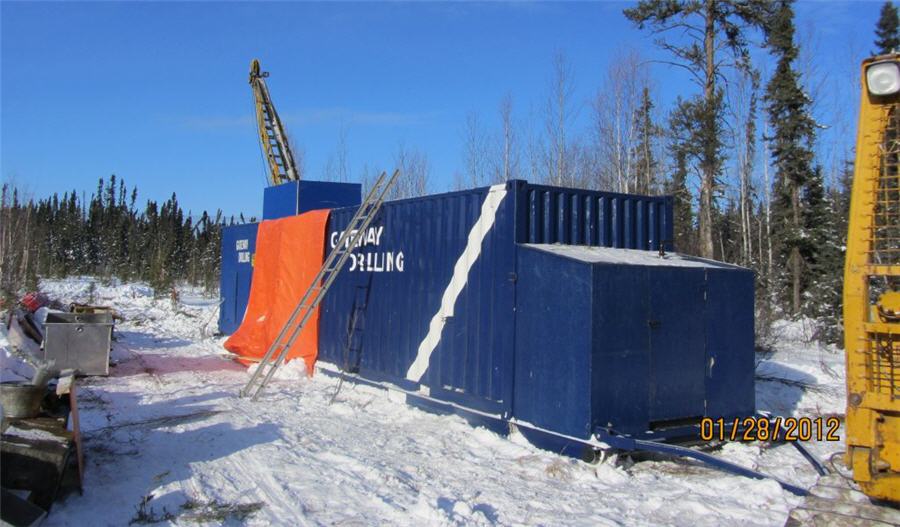
There’s been a recent bull rush for Canadian gold projects, and Comstock Metals Ltd. (TSX-V: CSL; US-OTC: CMMMF) sits in a good position with a pair of quality exploration plays in two exciting jurisdictions. The company has raised $5.5 million in the past 12 months, and is ready to get the drills turning.
A revitalized Comstock is now helmed by President and CEO Dr. David Terry, who previously worked as an economic geologist for a variety of major miners, including: Hemlo Gold Mines, Cominco, and Gold Fields Mining. Comstock completed a 5 to 1 share consolidation in 2016, and has emerged as a leaner vehicle focused on core exploration principles and geology.
“We started taking a fresh look at our assets and opportunities,” Terry recounts during an interview in Comstock’s Vancouver head office. “We’ve seen improvement in the markets, and it really couldn’t have come at a better time for us. We’re in a very opportune position with a core landholding in the Yukon, in what appears to be an emerging gold district; and a new acquisition in Saskatchewan we believe represents an under-explored area along a prospective greenstone belt.”

Pulling rods while drilling at the QV Gold Project in Yukon’s White Gold District. Photo Credit: Comstock Metals
Comstock is a familiar name in the Yukon as one of the early movers in prospector Shawn Ryan’s White Gold district. The company’s 163-sq.km QV property sits 70 km south of Dawson City; and 40 km due north of Goldcorp’s emerging Coffee gold development project.
Comstock discovered visible gold at QV in mid-2012 during prospecting to follow up on a gold-in-soil anomaly, with a grab sample running 16.28 grams gold per tonne.
Ryan has been a technical advisor to Comstock and recently added the nearby Golden Saddle deposit to his White Gold vehicle, which counts both Agnico Eagle Mines and Kinross Gold shareholders.
Comstock announced a maiden resource on QV’s VG zone in mid-2014 of 4.4 million inferred tonnes grading 1.65 grams gold per tonne for 230,000 contained oz. gold. The estimate is based on only 3,000 metres of drilling.
“It was a good starting point for the company,” Terry says. “The current resource occupies a very small portion of a very large property package in the heart of the White Gold district. We have the potential to not only expand the VG deposit with further drilling, but also to make additional discoveries. Shawn Ryan’s work has demonstrated that geochemical soil sampling is a very powerful tool in the Yukon.”
Comstock’s historical data includes 8,612 ridge and spur and grid-soil samples, a 773 line km airborne magnetic and radiometric geophysical survey, ground-magnetic surveys and 45 induced-polarization lines over the VG, Stewart and Shadow zones. The company also completed 3.6 km of trenching over 28 trenches, and collected 900 geoprobe samples along 6 line kilometres on the QV, Stewart and Shadow targets.
Shadow lies 12 km northwest of VG where two structures have been interpreted from magnetic data and surface mapping, including the northwest trending Spirit Fault, which corresponds to a 2.7 km long northwest trending gold-in-soil anomaly. Meanwhile, Stewart sits 5 km north of VG and covers a 1.5 km-long gold-in-soil anomaly.
Comstock has also identified gold mineralization on the QV grid at the Pump, North Star Adit, and GP2 zones. The targets all reportedly occur along east-northeast trending steeply-dipping faults that offset a prominent airborne magnetic high, which appears to be an analogous geological setting to that of the Golden Saddle deposit.
“Outside of the targets with detailed soil geochemistry grids we have identified a number of anomalous areas where we want to go back in and strategically tighten up our soil sample spacing,” Terry explains.
“Shadow is definitely an area where we want to do more work because there’s a really interesting gold-molybdenum soil anomaly to the north of the area where we carried out some initial RAB drilling last season,” he says.
Comstock has leveraged another technology that’s become prominent in Yukon exploration: rotary air blast (RAB) drill rigs. The portable, cost-efficient units are used to complete first-pass drilling on areas that demonstrate promising geophysical and geochemical signatures. It allows companies to increase target confidence before kick-starting the more-expensive diamond units.
In 2016, Comstock completed a 2,500-metre RAB campaign, with holes up to 150 metres deep.
Highlights of the RAB program include: extending the VG deposit along its western flank, where hole 17 cut 12.2 metres averaging 5.53 grams gold per tonne starting at 83.8 metres below surface; extension of the VG mineralized zone at least 200 metres to the northeast, where hole 14 intersected 11 metres of 1.65 grams gold starting 17 metres below surface; and a “potential new discovery” 200 metres due south of VG where hole 1 cut 3 metres of 7.8 grams gold from surface.
Furthermore, the company hit 9.1 metres of 0.7 gram gold from 53 metres depth in hole 29 during maiden drilling at Shadow.
“The RAB programs are a really efficient way to screen targets in a cost effective way and to advance exploration quickly,” Terry comments. “We’ve identified potential resource extensions and discovery targets last season, and we’re currently finalizing our 2017 exploration plans for QV. It’s certainly an exciting time for our company, and the jurisdiction.”

Drill on the first pad at Comstock Metals’ Preview gold project in Saskatchewan’s La Ronge belt in 2012. Photo Credit: Comstock Metals.
The La Ronge gold belt in north-central Saskatchewan has seen exploration booms over the past 30 years, including a rush in the 1980s when over 70 companies were combing the region for discoveries. More recently, mid-tier producer Silver Standard Resources paid $337 million in cash and shares for Claude Resources and its Seabee gold complex last year.
Comstock established a foothold in the region via an all-share deal with Select Sands (TSX-V: SNS; US-OTC: SLSDF) for the Preview SW gold project in late 2016. The property lies 80 km southwest of Seabee and has been the target of over 26,000 metres of drilling since 1985.
Preview has indicated resources of 2.6 million tonnes grading 1.89 grams gold for 158,300 contained oz. gold, and 5.7 million inferred tonnes at 1.48 grams gold for 271,000 contained oz. gold.
The project hosts seven known gold prospects from north to south: the North/Adit, C, B, A, SW, Clearwater A, and Clearwater B targets. Gold mineralization at Preview is interpreted as “structurally-controlled mesothermal lode gold found in quartz veins within, or on, the margins of sheared dioritic-gabbroic sills.”
“We evaluated the property last summer and decided it fit well with our project criteria. Saskatchewan is another terrific mining jurisdiction and you can’t beat the infrastructure,” Terry continues, noting the site is road accessible around 40 km north of La Ronge, Saskatchewan.
“It’s another situation where we have that dual upside of potentially extending known mineralization, and discovering new deposits. The style of gold mineralization at Preview is comparable to that found in prolific Archaean greenstone belts that are receiving a lot of exploration attention in Ontario and Quebec right now,” he adds.
Comstock kick-started its inaugural exploration program at Preview in early March, with a winter drilling program and a horizontal loop electromagnetic survey.
Initial drilling focused on the Preview North target, where previous drilling cut 5.7 metres of 18 grams gold from 10 metres depth in hole 13-163. The company is also testing targets near the Preview SW resource and along the “mineralized corridor that links the two areas.”
“We have extensive experience exploring for this style of gold mineralization and there is certainly a lot of prospective strike extent to test at Preview,” Terry explains. “Ground geophysics and the ongoing drill program are important steps in the process of understanding the controls on mineralization, and we’re also investing to improve our understanding of the metallurgy.”
Comstock completed nearly 2,000 metres of drilling at Preview through early May. Highlights include 5 metres averaging 10.33 grams gold per tonne from 40 metres depth in hole 17-166 at the North zone.
Meanwhile, the company had additional success at the main Preview SW deposit, where hole 17-169 intersected “multiple close-spaced vein zones” averaging 1.01 grams gold over 104 metres from 67.5 metres down hole.
“It’s a great start for us this year,” Terry concludes. “We hope to get the drill back in motion at Preview in late June, and start exploration at QV later this summer. There’s a buzz around the Canadian gold exploration sector right now, and we’re in a great position.”
— The preceding Joint Venture Article is promoted content sponsored by Comstock Metals Ltd and written in conjunction with The Northern Miner. Visit www.comstock-metals.com to learn more.